Squier Jazz Affinity Bass Long-Term Review
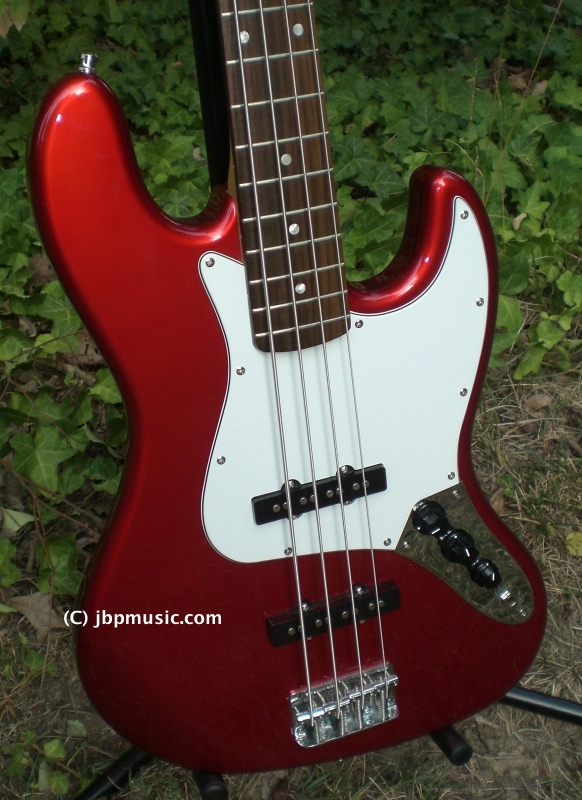 Squier Affinity J (Jazz) Bass long-term review
Squier Affinity J (Jazz) Bass long-term review
Every guitar player should try playing bass. It's a blast, and can really teach you something about fret stretches, silencing adjacent strings, and serious hand-strengthening. In another note, every bass player has to have a place to start. Sometimes getting a low-cost bass doesn’t mean having to get a
cheap bass!
Quick Opinion: The Squier Affinity and Standard Jazz Bass guitars are extremely comparable to Fender Mexican-made Standard Jazz Bass guitars! The basic features and appointments are almost identical. It stands to reason that the Chinese-made Squiers are slightly less-nice Alder wood, and the finish paint is thicker and harder on the Squiers. However, the impression of the Squier we bought (and have played for more than a year) is that it is a
solid buy, and an excellent bass.
 Free Shipping and more information about Squier by Fender Jazz basses - The Affinity 4-string Jazz may no longer be available, but check out the Vintage Modified!
Free Shipping and more information about Squier by Fender Jazz basses - The Affinity 4-string Jazz may no longer be available, but check out the Vintage Modified! Playability:
Playability: The neck is solid, and is nicely tapered. It is physically similar to Fenders costing much more… The maple neck and rosewood fretboard feel excellent and are easy to play. The bass is comparatively light and is fairly well balanced. The excellent Fender-designed double-cutaway body allows easy, full access to the entire fretboard.
As a long-scale (34”) bass, the Squier Jazz Bass is extremely playable and is a joy to use. The bolt-on maple neck/rosewood fretboard comes
surprisingly well finished. Only two or three of our guitar’s fret ends were a little sharp. The fret height is very consistent throughout the neck.
For folks with small hands or less-than-average arm lengths, a full-scale bass like this might be a little tough to play (especially during quick, challenging passes). If you’re not comfortable with a long, 34” guitar, I recommend trying out the Squier Bronco bass, or, if your budget can accommodate, a Fender Mustang bass.
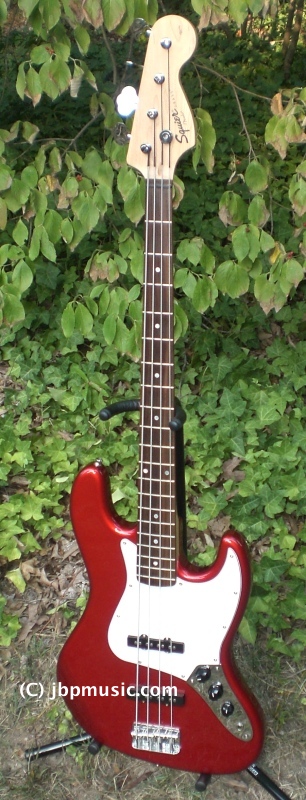 Features
Features The appointments and features of the Squier Jazz Bass are excellent for this guitar’s price. The pickguard is a well-made three-ply plastic guard (white-black-white on our Red Metallic bass). The pickups are two “vintage-style” pickups (bridge and mid). The guitar features two larger volume knobs and one smaller tone knob. The two volume knobs allow you to choose the tonal variety by selecting the volume for a specific pickup. The tone applies to the entire sound output (the Squier Jazz Bass guitars are
passive, in that they have no equalization or boost electronics on board). As with all Jazz Bass guitars, the neck is bolt-on. In the case of the Squier Jazz Bass, the neck truss rods are adjustable via an allen wrench in the headstock (no need to unbolt the neck and unscrew the pickguard). The chrome tuners are the enclosed variety, and are fairly accurate. The Squier Jazz uses a round string tree in the headstock for the two highest strings.
The Squier Jazz Bass has top-loaded strings (means that the strings are not fed through the body, but are fed through the end of the chrome bridge).
Sound: The Squier Jazz Bass guitar has a consistent, (sort of) vintage sound. The pickups are pretty noisy, and the output isn’t very strong. The quality of the sound that does come out is
all Fender, though. With the right amplification and EQ-tweaking, you can get the Squier to growl, rumble, and thumb-slap-“splank” without too much trouble. If I was to make this guitar my full-time bass – I might take the time to upgrade the pickups to Fender SCNs, or some type of high-output noiseless.
Value: This is a $299 guitar in value (not 'retail',
'street'). The sound, quality of make, and appointments are very good. Many other low-end guitars have badly twisted/warped necks, poor sound, and extremely cheap parts – the Squier Jazz Bass is very much a cut above the average low-end bass (no pun intended!). You would have to buy a much more expensive Fender bass to get better sound. If you took the labels off the Squier, you would have trouble telling it from its more expensive brethren (or sistren, if you wish).
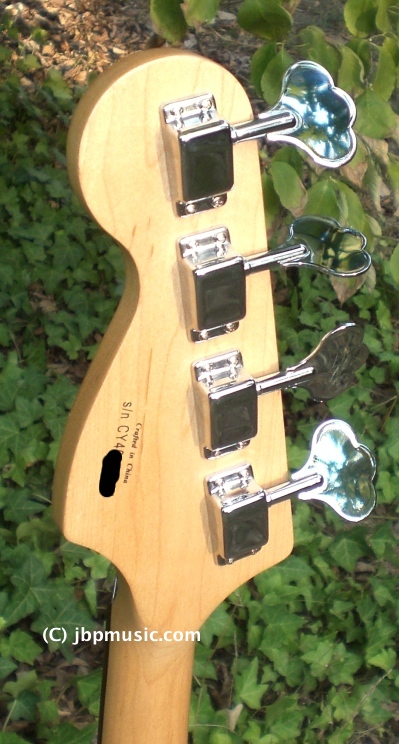 Wishes:
Wishes: I really wish these were offered with maple fretboards (a matter of personal preference, yes, but still something that would be good to offer). It would be nice if the pickups had more output.
Labels: 4 string bass, bass, electric bass, fender, jazz, squier
Ibanez AF-75D/AF75 Review - long-term impression
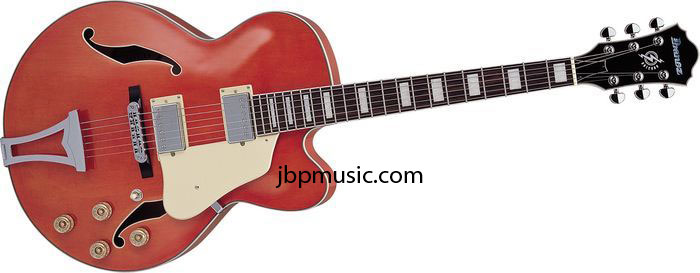
When I started playing guitar again (about a year and a half ago - after a 25-year break), one of my goals was to have different sounds with different types of guitars. One distinct sound for which I was looking was the jazzy/bluesy/open-body sound. In addition, I wanted the guitar to be able to rock 'n' roll.
A Second-Look: Ibanez AF75/AF75D long-term review
I visited my local guitar haunts and played just about every type and example of hollow- and semi-hollow-body electrics. My budget was $300 or less. To name a few, I played all of the Ibanez Artcore AF variants, several examples of the Epiphone Dot Studio, a few of the Carlo-Robelli/Brownsville types, and even a few used Gretschs and Gibsons (out of my budget range). I settled on a snappy and beautiful example of the Ibanez AF75D. Bear in mind that I played many examples of the same kind to get a feel for quality consistency and sound consistency. The one with which I came home was $319, and was a stunning example. I think I'd still like to have an Epiphone Dot Studio someday, but it was too far above my budget, and (frankly) I couldn't find an example with both a straight neck
and one with good electronics.
Quick Opinion: The Ibanez Artcore series are generally very well made. Most are made in China. The AF75D example I purchased ("Punkin") was exceptionally well made. The price was reasonable, and the sound quality is very much nicer than anything else in its price range. The guitar is chock full of features, has great parts, and plays like a dream.
I LOVE my AF75. Given the money in hand, I would buy another to put away for when I wear this one out.
See more info about the Ibanez AF75 here at GuitarCenter.com Playability:
Playability: The neck feels pretty quick and seems to be in the ballpark of Epis/Gibsons (short "feel" to the scale). The taper is just right, the fretboard was extremely nicely dressed and fitted, and the overall weight of the guitar is nicely light. After I fitted some Fender flatwound electric guitar strings (and substituted a plain 3rd instead of wrapped), the guitar played like a dream. The action adjusted to just the right height with little effort, and the reach of the single cutaway is very good - the top few frets of the low strings are a bit of a stretch.
Features The AF75 has two closed-cover humbuckers, binding on the neck, body, f-holes, and headstock. The tuners are very much like well-made grovers - very smooth and accurate. The trapeze and floating bridge combination makes for a wonderful and open sound (be careful, you must be prepared to do some measuring and intonation once you buy it - the position of the bridge is important to intonation). The three-way toggle is problem-free, and is fairly easy to reach. The individual volume and control knobs work fairly well in their purpose (they remind me of old Gibson Les Paul speed knobs). The body is laminated, but nicely shaped maple. The fit and finish overall is nearly as perfect as one could expect from a nicely-made guitar. The finish of the coloring is flawless - I really enjoy the "differentness" of the orange. The frets are medium, and are extremely well finished (I've played many $700+ guitars that don't have frets as nice as these).
Sound: The sound is open, airy, and wonderful. In any genre in which I play, this guitar can fit in. It is best for music from the 50s, 60s, and 70s - or Jazz or relaxed blues. It can play rock with the best of them, but the pickup output is too weak for hard rock/metal/thrash. In a loud band stage situation, the guitar can cause some feedback if placed too close to an amplifier (amazingly, this only happens in a few different melodic keys). The overall sound is crisp, clear, and refined. I'd rate the sound as something that is not as edgy as a Strat, but much mellower than a Les Paul or PRS.
Value: This is a $499 guitar in value (not 'retail',
'street'). The sound, quality of make, and appointments are top-notch for a bargain hollow/semi-hollow electric guitar, excellent. To get a better instrument, youíd have to go to a Gibson or a top-end Epiphone (Casino, etc.). This guitar is made in China, but you would have difficulty telling its origin from the excellent build quality. My local guitar stores now have them at $349 on the sticker. A case would be a good thing to get to protect your guitar - many different manufacturers make a case that works well with this guitar.
Wishes: Good instructions on bridge placement (for those who don't know how to adjust and place their bridge) would be essential. Stronger output from the humbuckers would be good, and a larger center-block to help keep feedback down would be good.
Labels: af-75, af-75d, af75d, electric guitar, hollowbody, ibanez
Fender 351-shape Lightweight Pick/Picks Review
This week, I am dipping into my Peck O’ Picks to review three of my most used flat-pick plectrums. In this case, the picks are
Fender™ 351-shape that fall into the “thin” or “light” category.
LOTS of variety and information about Fender traditional 351-shape picks here at GuitarCenter.com!
Picks (for those that use them) are probably the least expensive and least considered, but most important parts of guitar playing. Certain types and shapes of picks are best suited to playing a given type of guitar or even a given type of playing style. The thins covered in this review are generally used for soft strumming (particularly with acoustics), and for certain types of fast picking.
However, one of the least-considered and least-understood parts of picks is their affect on
clarity and brightness of attack. Most folks seem to focus on comfort (important, yes) and whether or not the pick lasts through hours of playing (also important, yes). In this review, I’ll consider these factors, but will focus more on how picks make attacks
sound.
Of the zillions of styles, picks and materials I have for picks, I go through the thins the most. Part of the reason is that thins/lights cause a very clean, precise (if not bright) attack on a given note. If the pick is held with only a little tip exposed to the string, the guitar’s sound becomes very clear and concise. If the pick is held far back away from the tip, the sound is a little softer, but gives an interesting “clicking” sound when recording a mic-ed acoustic. It is the brightness of attack that brings me to use a thin or light pick in certain of my tunes. At times, when I’m recording one of my acoustics (particularly when I double-mic from the front of the guitar) I like to use thins to give a nice “live” effect when I’m doing strummed chords.
The main disadvantage of
most thin picks is that they shred, crack, tear, or outright break fairly often. Most (
not all) common pick materials (celluloid and clear plastic included) will tear or break, particularly with fast or hard playing. My son cannot use a celluloid or clear plastic thin pick when he’s shredding – he’ll tear the pick within about an hour of playing something loud and hard. However, there
are thin picks made of materials that will last
significantly longer. In particular, the
Delrin™ Fender picks (and other brands, too, like the Dunlop™ Tortex™ and Ultex™ picks – covering those in another review sometime) last a very long time and are very hard to tear or break.
In short, if you want a bright note attack, use a thin or light pick. If you need durability, use one of the other materials, such as Delrin. Note that the Delrin picks have a slightly more warm-bright attack than do celluloid or clear plastic picks.
 The Fender Celluloid Thin (medium pictured here)
The Fender Celluloid Thin (medium pictured here): These picks come in neat "moto" colors and even some faux shell/pearl/abalone colorings. They’re generally low-cost, and can be purchased at almost any music store/catalog (an advantage). The lifetime of the celluloid picks is medium, and the attack sound is medium-bright. I like these picks for strumming 12-string guitars and my warmer-sounding guitars (Sycamore and Cedar). These particular picks are a very old standard, and are reliable enough to play through a jam set (most of the time) or a few weeks of light casual playing. I have only broken a few of these picks in the past couple of years – remembering that I have hundreds of picks and rotate through them frequently based on sound, style, and mood.
 The Fender California Clear™ Light clear plastic pick (medium pictured here)
The Fender California Clear™ Light clear plastic pick (medium pictured here): These picks have a
delightful, bell-clear attack that is better than any other brand or type I’ve tried (when it comes to a
bright attack). They come in lots of neat clear colors, and have a cool palm tree motif on the front. These picks are bright, but are extremely fragile. If you want brightness,
and 1) have lots on hand or 2) are a very light picker, these are the picks for you. I regularly break (or more appropriately, tear) one of these picks in any given recording session or
Jammin’ Rug jamming session. These picks receive awful reviews, mostly based on their short life spans. However, I always keep a dozen or so of them around specifically for their sound. I just assume that they are throw-away picks – they’re indispensable in my arsenal of sounds.
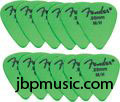 The Fender Delrin Light pick (medium pictured here)
The Fender Delrin Light pick (medium pictured here): This pick generally comes in plain, bright colors, and has a delightful non-gloss, very grippy texture. When these picks are new, they are great for sweaty paws – they don’t slip around much. As they age, they shine up a bit, but don’t lose their
edge. I have yet to break one of these, in any type of playing situation. My son has never broken one of these, either, even in two solid hours of hard rock playing and shredding. The Delrins have a bright attack, although not as clear as the Clears. These are more expensive (by a few cents) than the plastic and celluloid picks. They are also very hard to find in even mega-stores. I tend to buy these online by the dozen.
We'll dive back into the Peck O' Picks again soon to look at Nylons, and some other great brands of picks.
Labels: 351, classic, fender, pick, picks
Squier (Fender) Affinity Telecaster Tele Review

Some time back, I was in search for a low-action, fast-neck guitar that could both
twang and growl. On top of the need for such a beast, I had a very small amount of cash with which to work. Since I was lucky enough to have a double-humbucking guitar at the time, I really just needed… a
Telecaster™. Before I was seriously blessed by my brother’s gift of a Blonde American Deluxe Telecaster™ (thanks, Bro!!!), I needed the use of a Tele™ for more than a year.
Enter the Squier™ Affinity Telecaster!
I went to my usual haunts, the Guitar Center and Sam Ash (my wife wishes I hadn’t found those places :-) - but she’s so wonderfully tolerant!). I played 6 examples of Squier Affinity Telecasters. I tried several different individuals – all of which had been whacked around pretty good as floor models. I was blown away at how this particular variety of guitar felt and sounded. The key here is that the two largest concerns I have when purchasing guitars are: 1) The sound the guitar can make through average amplifiers (I’m on a budget – no $2500 Buddhas here); and 2) The way the
guitar as a whole feels when I’m playing it.
I found one particular Squier Tele that I enjoyed a great deal, but it was not the color I wanted, and it had too many sales-floor-bang-ups. If I’m going to buy a bargain guitar, I really want the color I want and I don’t want one that has been whacked up by anyone but me or my son. I ended up settling on taking a chance with an online purchase from Musician’s Friend
Free Shipping and lots of information about the Squier by Fender Affinity Telecaster here at GuitarCenter.com
- I’m glad I did.
Quick Opinion: I generally like Fenders, but my budget was
really tight this time around.
Even the very modestly-priced $399 Mexican-made Fender Tele was way out of reach this time around.
That said, I was REALLY blown away by the quality, finish, playability and sound of this $169 Tele! If I closed my eyes and picked up the Fender and the Squier in succession, I would be hard pressed to tell the difference. The sound is better in the Fender, but not in terms of leaps and bounds. The neck and the pickups of the Fender are better (realistically), but the
playability of the Squier is fantastic!
Playability: The neck is a delightful satin-finish flat-ish "c"-ish shape hard maple two-piecer.
The frets are finished surprisingly well, with only a few end-burrs, and no inconsistency in fretwire height or finish. The frets could have been polished a little nicer – but you can do that yourself pretty easily with the right polishing paper/cloth. The scale is just right – medium. There are no buzzy frets on the example I purchased. The string height is very low, but only exhibits a little buzz – the buzz does not carry out into the sound through the pickups (only acoustically). I decided to leave the string height as-is – and replaced the factory strings (.09 Supers) with Stainless 3350s. The neck is really quick and the strings play out like hot butter! The only drawback is that the neck is a little thin for me (others may find it to be great, but I like to get a grip on my guitar necks).
The weight and balance of the guitar as a whole is excellent. It’s not overly neck-light (as are some Squier instruments), and the feel of the instrument’s construction is solid. The instrument is not as light as an Ash Tele, but won’t cramp your style in hours of spankin’ the fretboard plank. The hardware was finished flawlessly, and the electronics are clean enough.
Sound: Despite the slightly buzzy (normal for $169 guitars) pickups, the output of the pickups is surprisingly strong. If you were to put some Tex Mex Custom shops or some
GFS Alnico pups (I’m gonna get some fairly soon myself! They’re a bargain!) in this guitar, it would absolutely scream - for not a lot of bucks. I found that running this guitar through some interesting Line6 guitar models made this guitar really sing!
Value: This is a $249 guitar in value (not 'retail',
'street'). The sound, quality of make, and appointments are top-notch for a bargain electric guitar, excellent. To get a better instrument, you’d have to spend $399. This guitar is made in China, but you would have difficulty telling its origin from the excellent build quality. I have since seen the
Butterscotch Blonde version of this Tele – looks great!
Features: This is an excellently-designed instrument. It has the bits needed for daily use and for recording alike. The finish on the body is even and consistent. The neck finish is without remark, and the tuners are remarkably good for this price range… Overall, Telecasters are simple and genius at the same time.
A Small Issue at Delivery: When I received my Squier Tele, the nut had been cut incorrectly at the factory. The slots were not spaced very well, and the overall height of the nut was much too low. The 1st and 2nd strings had a bind-buzz from pinching at the nut, and the strings were way too close to the first and second fretwires. I called Musician’s Friend that day, and (as is very much usual), their customer assistance was excellent – they shipped out a
GraphTec replacement nut (an upgrade – I don’t have the tools to slot an OEM Fender nut) immediately at no charge. I replaced the nut on its arrival and have since become a
big fan of GraphTec’s guitar nuts. The bending is easier and the intonation stays put longer when I’m using one of their nuts. The nut was a little bit wide for the Tele’s neck, but not enough to get sideways about it – I don’t have a problem with the fact that it is not flush left-to-right.
Wishes: I'm glad to have the GraphTec nut, but I wish I hadn't had to deal with the problem. A tinted neck would really look nice!
Labels: affinity, electric guitar, fender, guitar, squier, tele, telecaster









